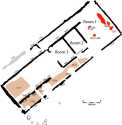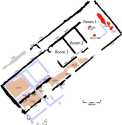

Left: Mid-Roman Masonry Building 3
Right: Mid-Roman Masonry Building 3 overlying Early Roman Masonry Buildings 1 and 2


Left: Mid-Roman Masonry Building 3
Right: Mid-Roman Masonry Building 3 overlying Early Roman Masonry Buildings 1 and 2
Period 4 sees the subsuming of the remains of Period 3 Early Roman Masonry Building 2 into those of Early Roman Masonry Building 1, suggestive perhaps of one branch of the family expanding at the expense of the other. It is extremely difficult to ascertain the function of different rooms, not least because it is by no means certain which elements of the plan are secure. Was Period 3 ERMB1 demolished in its entirety, or were the walls of Rooms 2 and 3 retained? What is clear is that metalworking continued to be focused at the north-east end of the building and that it might have included the working of precious metals a well as copper alloys. Equally uncertain is the fate of Early Roman Timber Building 4 and the space which it occupied. There is plenty of third century pottery from the north-east corner which is summarily reported in Fulford et al. (2006), but even less structural evidence than for Period 3.
Chronology is not clear either, not least because, in the absence of clearly defined floor surfaces, it was difficult to distinguish between contexts which might be attributable to one building period rather than the other. The demolition of its predecessors and the construction of Mid-Roman Masonry Building 3 centres on AD 200, but could lie within the range of 175-225. The end of the occupation, however, is much clearer because there was a clear horizon of activity involving the digging of pits into the demolished remains of the building starting soon after about 250.
As far as function is concerned, Mid-Roman Masonry Building 3 is interpreted as a town house, but with evidence for metalworking in the end (north-east) room. This seems to represent a continuation of activities identified in Period 3.
© Internet Archaeology
URL: http://intarch.ac.uk/journal/issue21/4/p4_overview.htm
Last updated: Wed Sept 12 2007